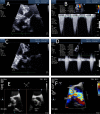Stress echocardiography in patients with morbid obesity
- PMID: 27249552
- PMCID: PMC4989093
- DOI: 10.1530/ERP-16-0010
Stress echocardiography in patients with morbid obesity
Abstract
The incidence of significant obesity is rising across the globe. These patients often have a clustering of cardiovascular risk factors and are frequently referred for noninvasive cardiac imaging tests. Stress echocardiography (SE) is widely used for assessment of patients with known or suspected coronary artery disease (CAD), but its clinical utility in morbidly obese patients (in whom image quality may suffer due to body habitus) has been largely unknown. The recently published Stress Ultrasonography in Morbid Obesity (SUMO) study has shown that SE, when performed appropriately with ultrasound contrast agents (whether performed with physiological or pharmacological stress), has excellent feasibility and appropriately risk stratifies morbidly obese patients, including identification of patients who require revascularization. This article reviews the evidence supporting the use of echocardiographic techniques in morbidly obese patients for assessment of known or suspected CAD and briefly discusses other noninvasive modalities, including magnetic resonance and nuclear techniques, comparing and contrasting these techniques against SE.
Keywords: cardiac imaging; obesity; stress echocardiography; ultrasound contrast.
© 2016 The authors.
Figures

Similar articles
-
The clinical impact of contemporary stress echocardiography in morbid obesity for the assessment of coronary artery disease.Heart. 2016 Mar;102(5):370-5. doi: 10.1136/heartjnl-2015-308796. Epub 2016 Jan 6. Heart. 2016. PMID: 26740479
-
Stress echocardiography for the diagnosis of coronary artery disease: an evidence-based analysis.Ont Health Technol Assess Ser. 2010;10(9):1-61. Epub 2010 Jun 1. Ont Health Technol Assess Ser. 2010. PMID: 23074412 Free PMC article.
-
Magnetic resonance imaging (MRI) for the assessment of myocardial viability: an evidence-based analysis.Ont Health Technol Assess Ser. 2010;10(15):1-45. Epub 2010 Jul 1. Ont Health Technol Assess Ser. 2010. PMID: 23074392 Free PMC article.
-
European Association of Cardiovascular Imaging/Cardiovascular Imaging Department of the Brazilian Society of Cardiology recommendations for the use of cardiac imaging to assess and follow patients after heart transplantation.Eur Heart J Cardiovasc Imaging. 2015 Sep;16(9):919-48. doi: 10.1093/ehjci/jev139. Epub 2015 Jul 2. Eur Heart J Cardiovasc Imaging. 2015. PMID: 26139361 Review.
-
Italian Society of Cardiovascular Echography (SIEC) Consensus Conference on the state of the art of contrast echocardiography.Ital Heart J. 2004 Apr;5(4):309-34. Ital Heart J. 2004. PMID: 15185894 Review.
Cited by
-
Anaesthetic Preparation of Obese Patients: Current Status on Optimal Work-up.Curr Obes Rep. 2017 Sep;6(3):229-237. doi: 10.1007/s13679-017-0268-5. Curr Obes Rep. 2017. PMID: 28707209 Review.
-
Use of Ultrasound Contrast Agents in Stress Echocardiography: Three for the Price of One.CASE (Phila). 2025 Apr 14;9(6):194-199. doi: 10.1016/j.case.2025.01.007. eCollection 2025 Jun. CASE (Phila). 2025. PMID: 40583874 Free PMC article.
-
Point-of-Care Echocardiography in the Difficult-to-Image Patient in the ICU: A Narrative Review.Crit Care Explor. 2024 Jan 11;6(1):e1035. doi: 10.1097/CCE.0000000000001035. eCollection 2024 Jan. Crit Care Explor. 2024. PMID: 38222871 Free PMC article. Review.
-
Obesity and Anesthesia: Challenges in the Perioperative Period.Mo Med. 2024 Mar-Apr;121(2):156-163. Mo Med. 2024. PMID: 38694600 Free PMC article. Review.
-
Clinical, Safety, and Engineering Perspectives on Wearable Ultrasound Technology: A Review.IEEE Trans Ultrason Ferroelectr Freq Control. 2024 Jul;71(7):730-744. doi: 10.1109/TUFFC.2023.3342150. Epub 2024 Jul 9. IEEE Trans Ultrason Ferroelectr Freq Control. 2024. PMID: 38090856 Free PMC article. Review.
References
-
- World Health Organization (WHO) 2013. Obesity and overweight. Access date 15 January 2014 Geneva, Switzerland: WHO; (available at: http://www.who.int/mediacentre/factsheets/fs311/en/)
-
- Plana JC, Mikati IA, Dokainish H, Lakkis N, Abukhalil J, Davis R, Hetzell BC, Zoghbi WA. 2008. A randomized cross-over study for evaluation of the effect of image optimization with contrast on the diagnostic accuracy of dobutamine echocardiography in coronary artery disease the OPTIMIZE trial. JACC: Cardiovascular Imaging 1 145–152. 10.1016/j.jcmg.2007.10.014 - DOI - PubMed
Publication types
LinkOut - more resources
Full Text Sources
Other Literature Sources
Miscellaneous

